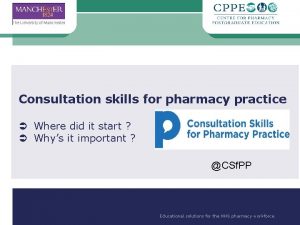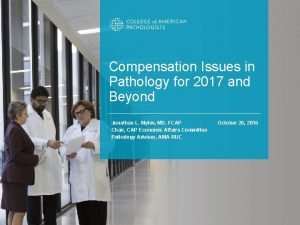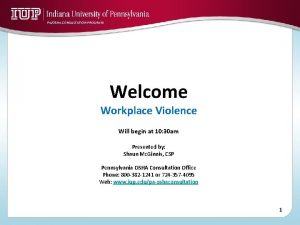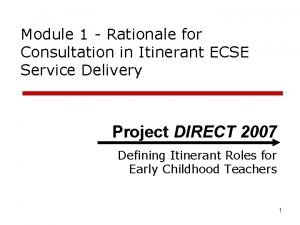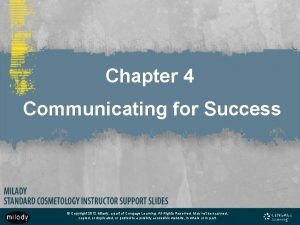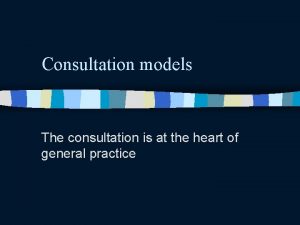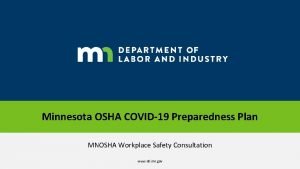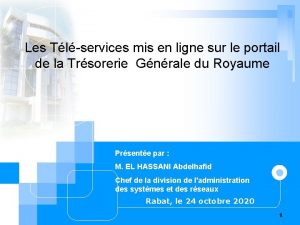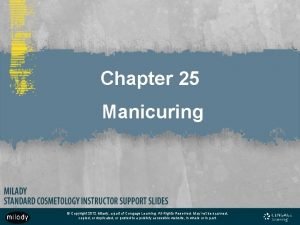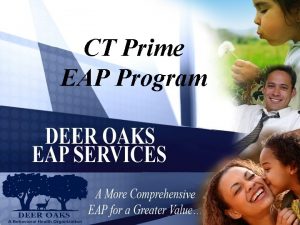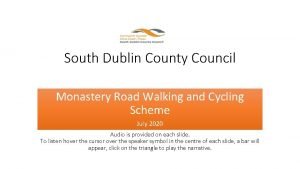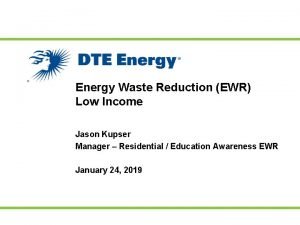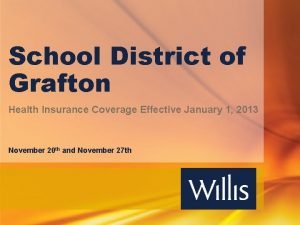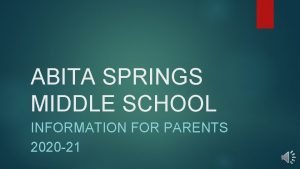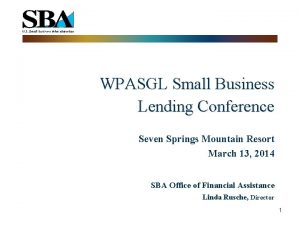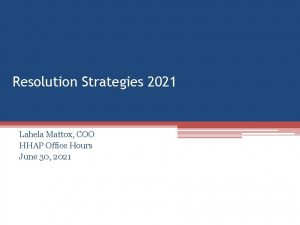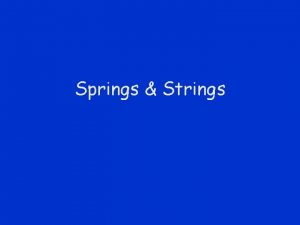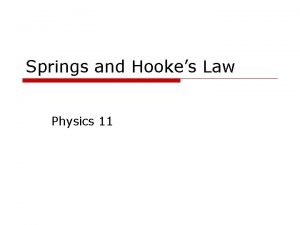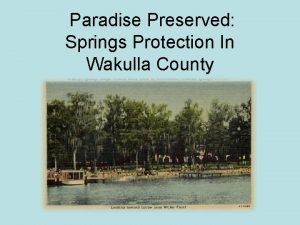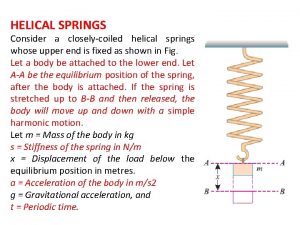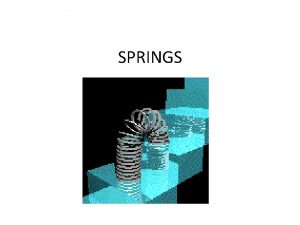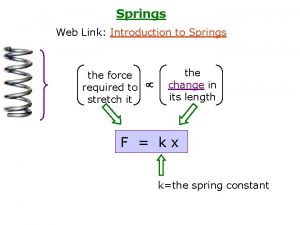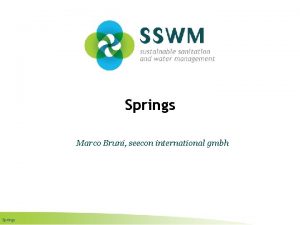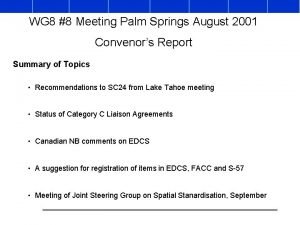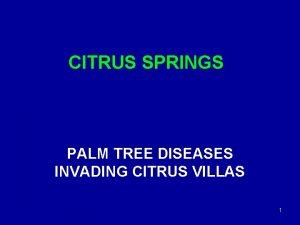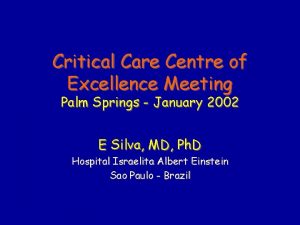HHAP Consultation Palm Springs Presentation to Palm Springs






































- Slides: 38

HHAP Consultation: Palm Springs Presentation to Palm Springs City Council January 29, 2020

Barbara Poppe and Associates The collective for impact Barbara Poppe is the founder of Barbara Poppe and Associates and the former executive director of the United States Interagency Council on Homelessness, 2009 -2014. During her tenure, Opening Doors, the first comprehensive federal strategic plan to prevent and end homelessness was launched in June 2010. Ms. Poppe is a nationally recognized expert on homelessness and resultsdriven public-private partnerships. Ms. Poppe serves on the national board of the Enterprise Community Partners and the national advisory board for the Center for Evidence-based Solution to Homelessness.

Overview • Grounding in best practices and definitions • Purpose of consultation & process • Background on HHAP • Key Leader perspectives • Options and opportunities for HHAP investment • Q&A

Causes and consequences of homelessness January 2020 Housing is out of reach supply and affordability Inadequate income – chronic and crisis Health issues – chronic and crisis Domestic violence & trauma recent and lifetime 4

Keys to success The Path Forward: recommendations to advance an end to homelessness in the Coachella Valley Housing Solutions Crisis Response Alignment

Recommendations Community Engagement and Leadership Establish the Coachella Valley Collaborative to End Homelessness Increase Exits to Housing and Services • Scale up Permanent Supportive Housing (PSH) that uses best practices approach and increase access to housing and services in other settings • Increase access to affordable rental housing by preserving existing housing options and establishing a coordinated and collaborative landlord recruitment initiative • Align Rapid Rehousing (RRH) funding and practices with best practices approach; scale up as needed Improve Cross-Sector Responses • Implement an enhanced Health Home Program to prevent homelessness and assist homeless individuals to exit more quickly to stable housing with services • Establish an early childhood and school-based collaborative for homelessness prevention programs to stabilize the most vulnerable children and families Improve Crisis Response • Scale up diversion assistance or “assisted rapid resolution” (problem-solving with access to flexible financial assistance) across the Coachella Valley • Establish a true, collaborative crisis response system to provide a more comprehensive response to homelessness across the Coachella Valley The Path Forward: recommendations to advance an end to homelessness in the Coachella Valley

Definitions • Rapid resolution is aimed at keeping households from becoming homeless by providing services that permit them to stay safely in current housing or, if that is not possible, move to other housing without lapsing into homelessness. Priority is given to households who are most likely to be admitted to shelters or be unsheltered if not for this assistance. • Rapid Rehousing includes housing identification, rent and move-in financial assistance, case management, and other services available to households who have become homeless. This approach places a priority on moving a family or individual experiencing homelessness into permanent housing as quickly as possible, and then working with the household for an extended period—from several months to two years—to meet their living expenses.

Definitions • Bridge Housing is interim housing used as a short-term stay when an individual has been offered and accepted a permanent housing intervention but, is not able to immediately enter the permanent housing. AKA – Crisis Stabilization Housing • Permanent supportive housing (PSH) is decent, safe, affordable, communitybased housing that provides disabled tenants with the rights of tenancy and links to voluntary and flexible supports and services for people with disabilities who are experiencing chronic homelessness.

Purpose of consultation with Palm Springs • Build from the earlier work for the Desert Healthcare District and Foundation in 2018 The Path Forward: recommendations to advance an end to homelessness in the Coachella Valley • Share best practices and strategies that other communities have successfully implemented • Solicit input and ideas • Share expert advice and generate ideas for City Council who will develop a plan to apply for HHAP

Key leader interviews Document review Consultation Process Focus group Site visit Council working session Recommendations

Proposal should: • conform to the HHAP requirements City of Palm Springs’ HHAP Application • contribute to measurable reduction in homelessness within Palm Springs • align with and support the regional approach to homelessness • identify cost efficient, rapidly deployable, building technologies, practices, financing strategies, and policies that can be implemented in Palm Springs and replicated in other communities • leverage other funding sources, partnerships, and resources • invest in projects that are best able to be sustained beyond these one-time HHAP investment

Homeless Housing, Assistance and Prevention Program (HHAP) • To support regional coordination and expand or develop local capacity to address immediate homelessness challenges throughout the state. • Spending must be informed by a best practices framework focused on moving homeless individuals and families into permanent housing and ensuring those individuals and families to maintain their permanent housing. • $10 M is dedicated to the City of Palm Springs.

Other information about HHAP • Prohibited: shall not use HHAP grant program funding to supplant existing local funds for homeless housing, assistance, or prevention. • Mandated: use at least 8 percent of their funds for services specific to the needs of homeless youth. • Permissive: use funds for the following: • Up to 5 percent of an applicant’s program allocation may be expended on a strategic homelessness plan and/or infrastructure development to support Coordinated Entry Systems (CES) and Homeless Management Information Systems (HMIS). • Up to 7 percent of a program allocation may be used for a jurisdiction’s administrative costs incurred to administer the funds. This does not include staff costs or other costs directly related to

Eligible uses for HHAP • Rental assistance and rapid rehousing; • Operating subsidies in new and existing affordable or supportive housing units, emergency shelters, and navigation centers. Operating subsidies may include operating reserves; • Landlord Incentives (including, but not limited to, security deposits and holding fees); • Outreach and coordination (which may include access to job programs) to assist vulnerable populations in accessing permanent housing and to promote housing stability in supportive housing; • Systems support for activities necessary to create regional partnerships and maintain a homeless services and housing delivery system particularly for vulnerable populations including families and homeless youth; • Delivery of permanent housing and innovative housing solutions (such as hotel and motel conversions); • Prevention and shelter diversion to permanent housing; and • New navigation centers and emergency shelters based on demonstrated need.

• Coachella Valley Rescue Mission • CV HEART collaborative • CVAG • Desert AIDS Project Key Leader interviews • Martha’s Village and Kitchen • Palm Springs Police Department HOT team • Path of Life Ministries • Riverside County Executive Office • Riverside Housing Authority • Riverside University Health System - Behavioral Health • Well in the Desert

Who is homeless and why? • Predominately, single adults/couples without children are experiencing homelessness in Palm Springs • Very few children or youth • Growing number of seniors • Most challenging are people with severe, persistent mental illness and addiction • Rents are increasing. City of Palm Springs is not building/replacing rental housing for lower income households, including seniors • Seasonal workers – few jobs during summer so unable to pay rent and become homeless.

Collaboration • City of Palm Springs is viewed positively as good collaborator on services delivery with more active engagement recently. • Collaboration is improving among nonprofit organizations, but mistrust and miscommunication remain • CV HEART is gearing up publicly not but has been working informally for past several months to bring providers together.

What’s happening – reducing inflow and preventing homelessness? What’s working? What’s not working? • Rapid resolution • Transportation assistance • New MVK medical respite program • Feeding programs • Eviction due to rising rents, especially seniors • Households with financial crisis are at risk of eviction • Discharge from recovery/sober living centers

What’s happening to address homelessness? Positives Comment • Shared housing and PSH is successful • Landlord engagement • Well in the Desert provides important day services • Year-round overnight shelter/cooling center at Boxing club • CVAG’s new multi-service center Boxing club helps a little bit. Decreases immediate needs, slightly more organized but doesn’t help people really selfresolve, and is unlikely to create ways for more folks to get off the streets.

What’s happening to address homelessness? Housing Challenges Comment • Affordable apartments, Permanent Supportive Housing (PSH) slots and units • Full & shallow subsidies for disabled, elderly, and working poor • Landlords willing to take people with poor credit, prior eviction and/or criminal histories. It is not hard to find people who want to leave the streets, it’s hard to put them in housing.

What’s happening to address homelessness? Crisis Challenges • 24/7 shelter beds • Many people won’t access congregate shelter • Connecting to benefits • Timely access to medical detox, services for people with mental illness • Response to some physical health issues Comment People who are unsheltered are mobile so hard to consistently connect to services and find when housing match occurs.

What are ideas to better address homelessness? • Build more permanent supportive housing • Expand crisis stabilization units (bridge housing) • Build out navigation center on city owned property at Boxing Center • Figure out cheap ways to serve easiest to rehouse people • Provide more access to showers, laundry restrooms, and safe storage

Overarching Recommendations 85% Dedicated to new housing and services 8% Mandatory youth set-aside 7% Admin, leadership & accountability 0% Planning/CES/HMIS (if feasible)

Potential allocation of funds USES AMOUNT Youth set aside $ 800, 000 Admin, leadership & accountability $ 700, 000 Program purposes $ 8, 500, 000 Total $ 10, 000

Develop and implement contract/grant standards for performance and outcomes, HMIS participation, collaboration with other providers, alignment with best practices, and compliance on all city grants(in addition to HHAP) – require regular reports to Council committee Leadership & accountability Launch civic engagement campaign to raise private funding and capital investment, pro bono services, and build cohesive community response to address homelessness Dedicate position to function as Housing Initiatives Director and collaborate with CVAG, Co. C, Riv. Co and others – develop clear action plan with benchmarks and metrics and provide regular reports to Council committee

Create new PSH and bridge housing units Options: Housing One shot and rapid rehousing financial assistance to exit homelessness Landlord engagement and incentives

Definitions • Bridge Housing is interim housing used as a short-term stay when an individual has been offered and accepted a permanent housing intervention but, is not able to immediately enter the permanent housing. AKA – Crisis Stabilization Housing • Permanent supportive housing (PSH) is decent, safe, affordable, communitybased housing that provides disabled tenants with the rights of tenancy and links to voluntary and flexible supports and services for people with disabilities who are experiencing chronic homelessness.

Permanent Supportive Housing CAPITAL DEVELOPMENT RENTAL ASSISTANCE (OPERATING) LAND SERVICES PSH

Potential partners Create new PSH and bridge housing units • State of California as funding partner • Lift to Rise, LISC/NEF, and/or Enterprise to help raise private capital • Riverside County - HOME funds/other resources and pool SB 2 funds. • Housing Authority for project-based housing vouchers • DBH for NPLH investment, and ongoing intensive case management and other services; funding for bridge housing subsidies (on-demand) • DPSS for funding for bridge housing subsidies (on-demand) • Health Systems, Health Centers (e. g. Borrego, DAP, Clinicas, and County FQHCs) and IEHP for services, capital investment, and bridge housing subsidies • Agua Caliente tribe, school system, churches, others who can provide free/low cost land

Development models Create new PSH and bridge housing units • Dedicate units within new affordable rental housing • Rehab existing apartments and dedicate some/all units • Motel conversion • Purchase scattered site condos • New build on city owned or other free land

City of Palm Springs roles Create new PSH and bridge housing units • Identify potential sites and provide land • Use state streamlining tools to expedite development • Offer other incentives for projects

Prevent homelessness for seniors at risk • Emergency and shallow rent assistance • Partner with Riv. Co Options: Prevention Expand Rapid Resolution • Flexible financial assistance • Partner with CVAG Reduce discharges from treatment and other institutions into homelessness • Partner with CVAG

24/7 Navigation Center with 50 low barrier crisis beds for individuals who are chronically homeless and/or highly vulnerable Options: Crisis Response Engage faith-based and other civic organizations to establish safe shelter options across west valley for families with children and adults/couples who can resolve homelessness with light touch services Improve day services to create safe, accessible storage options and shower/restroom/laundry facilities

HHAP Definition: Navigation Center • Housing First, low-barrier, service-enriched shelter • Focused on moving homeless individuals and families into permanent housing • Provides temporary living facilities while case managers connect individuals experiencing homelessness to income, public benefits, health services, shelter, and housing.

Not recommended for HHAP investment • Supplanting grant program funding to supplant existing local funds for homeless housing, assistance, or prevention [HHAP prohibition] • New outreach services [current efforts should be sustained] • Crisis response investment only [will not reduce homelessness] • Co-located services only [needs to be connected to housing placement] • Ongoing operating costs [HHAP is one-time]

Overarching Recommendations 85% Dedicated to new housing and services 8% Mandatory youth set-aside 7% Admin, leadership & accountability 0% Planning/CES/HMIS (if feasible)

Recap of priorities for HHAP Housing (and more housing) Prevention Crisis response Support

Questions?
 Palm springs google drive
Palm springs google drive Adiantum spp. – maidenhair fern
Adiantum spp. – maidenhair fern Protea senior living
Protea senior living Palm and thumb grasp
Palm and thumb grasp Behavioral consultation
Behavioral consultation Consultation skills for pharmacy practice
Consultation skills for pharmacy practice Microslide consultation
Microslide consultation Pa osha consultation
Pa osha consultation Wedding consultation form
Wedding consultation form Balint model of consultation
Balint model of consultation Consultation collocation
Consultation collocation Triadic consultation model
Triadic consultation model Chapter 4 milady
Chapter 4 milady Models of consultation
Models of consultation Minnesota osha
Minnesota osha Consultation skills for pharmacy practice
Consultation skills for pharmacy practice Bradford vts consultation models
Bradford vts consultation models Practice standards for consultation skills
Practice standards for consultation skills Neighbours inner consultation model housekeeping
Neighbours inner consultation model housekeeping Www.tgr.gov.ma consultation
Www.tgr.gov.ma consultation Manicure steps milady
Manicure steps milady Neighbours model of consultation
Neighbours model of consultation Balint consultation model
Balint consultation model Caplan's four types of consultation
Caplan's four types of consultation Deer oaks consultation services
Deer oaks consultation services Pendleton consultation model
Pendleton consultation model Sdcc consultation portal
Sdcc consultation portal Dte home energy consultation
Dte home energy consultation Home buyer consultation
Home buyer consultation Triadic dependent
Triadic dependent Service delivery consultation
Service delivery consultation Humana agent near me
Humana agent near me 5cm labor
5cm labor Fundal height transverse lie
Fundal height transverse lie Dripping springs ffa
Dripping springs ffa Abita springs middle school
Abita springs middle school Naviance ccisd clear springs
Naviance ccisd clear springs Amelia givin library
Amelia givin library Small business loans in seven springs nc
Small business loans in seven springs nc





